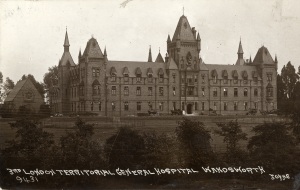The meeting of Wandsworth Borough Council on 28th July was a largely uncontroversial affair, with the reports in the Wandsworth Borough News mainly covering Council decisions without any debate. Economy was driving many of the decisions made by the Council, as well as patriotism, with a decision to dispense with all members of temporary staff who were eligible to serve with the Armed Forces. An appeal by the Central Charities Committee of the Social Welfare Association for London to consider filling temporary posts with Belgian employees was met with a decision to do so only when the Belgians were not eligible to serve with the Belgian Army.
The decisions were partly fuelled by the need to save money but presumably also the enthusiasm for the local battalion, the newspaper reported that after 4 weeks nearly 900 men were wearing the uniform of the new battalion and it was expected to reach full strength in the next few days. Young’s had placed the Ram Brewery yard at the disposal of the regiment as a parade ground and Council support for the battalion included free use of the baths, as well as offices and support for the recruiting staff. A recruiting rally at King’s Hall, Tooting had produced 30 new recruits, all of whom were given a half-sovereign by the proprietor as a “reward for valour”.
A desire to help the troops was also behind another appeal in the Borough News, that of a Mr R Stanley Grint, Ilminster Gardens. Mr Grint was appealing for any bowls which were no longer required, or for funds to purchase new bowls, which could be given to the “Tommies” at the 3rd London General Hospital on Wandsworth Common. The hospital is perhaps the source of this advert in the paper:
Intelligent young men wanted age 17 and under 19 to serve for duration of War at a Military Hospital as Hospital Orderlies. Home Service. Pay 8s 2d per week, all found. Address: Sergt Major, Borough News, Wandsworth.
Finally, the paper did have one controversy to report on – the decision of the Wandsworth Board of Guardians to stop using butter and start using margarine instead. This a “war measure”, prompted by economy, but led to much argument over the merits of both substances. Miss Hill had been very against margarine, but had recently tried “Maypole” and claimed her family did not know the difference, whilst Mr W H Smith said that margarine was often supplied instead of butter in the best restaurants and he saw no objections to it. Other board members argued about the nutritional value, and if all officials should have the same restriction or merely the inmates and patients. Mr Couzens refuted the argument that some prefer margarine by stating he had tasted it last Tuesday and should certainly not prefer it to butter. Eventually the arguments for either, and the claims not to know the difference, resulted in the decision to use margarine.
Wandsworth Council minutes, ref: MBW/1/15
Wandsworth Board of Guardians minutes, ref: WCU
Wandsworth Borough Newa available on microfilm


